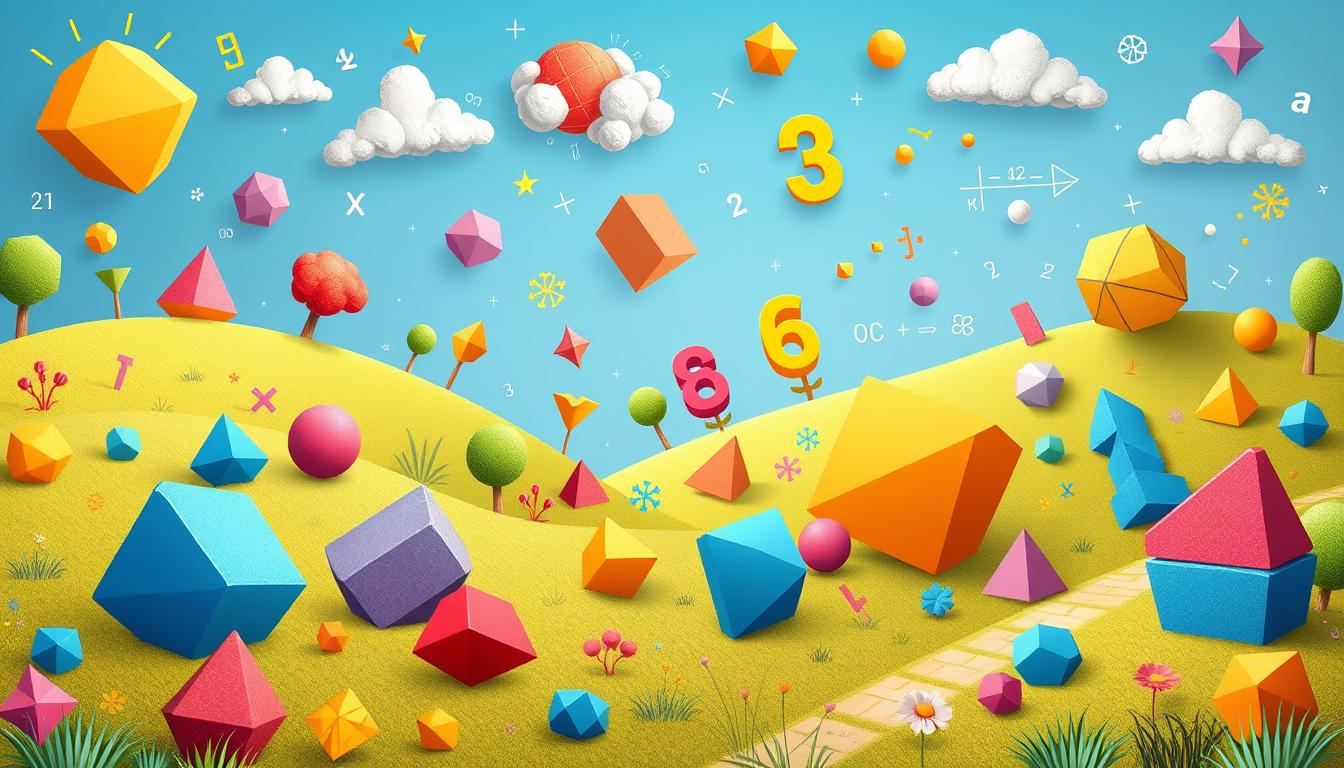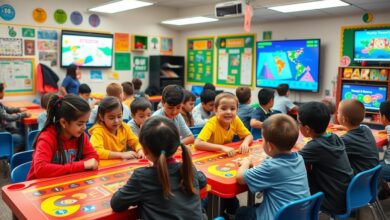Math Play: Making Learning Fun & Boosting STEM Skills

Table of Contents
Play pedagogy can change how students view mathematics. It makes them excited and interested. In traditional math lessons, math can seem difficult and intimidating. However, by using fun learning methods, you can help students love solving math problems.
This article will show you how to make math fun. You will learn how to improve your students’ math experience.
Understanding the Power of Play Pedagogy in Learning
Learning math isn’t just about reading books. It’s about using math play. This method lets students explore and discover math in a fun way. It helps them understand numbers and think critically.
The Science Behind Playful Learning
Playful learning is backed by science. When students play with math, they learn better. They become good at problem-solving and creative thinking.
Benefits of Math Engagement
- Improved retention and comprehension of mathematical principles
- Enhanced critical thinking exercises and analytical skills
- Increased motivation and enthusiasm for math learning
- Opportunities to apply mathematical concepts in real-world scenarios
Building Math Confidence Through Play
Math play changes how students see math. It makes learning fun and exciting. This way, students feel more confident and ready to tackle math challenges.
“The real joy in mathematics lies in the process of discovery, not just in the destination. Playful learning harnesses this innate human curiosity, opening up a world of possibilities.”
Essential Math Games for Transformative Learning
Math games can spark a love for STEM learning in your students. They improve problem-solving skills and make math beautiful. Explore interactive games that turn your classroom into a zone for math discovery.
Fun Math Games for All Ages
Find math games for all ages and skill levels. These activities mix math with fun, making learning exciting. Your students will be eager to learn and grow.
- Number Sense Builders: Games like “Multiplication Mash-up” and “Fraction Frenzy” improve number and fraction understanding.
- Spatial Reasoning Boosters: “Tangram Teasers” and “Geometric Gems” enhance spatial awareness and geometry skills.
- Problem-Solving Powerhouses: Games like “Cryptarithms” and “Logic Loot” boost critical thinking and problem-solving.
Integrating Math Games into STEM Learning
These math games fit perfectly into STEM learning. They make learning more exciting and help develop important skills. By using these games, you can deepen your students’ math knowledge and prepare them for the future.
| Game | Mathematical Skills | STEM Integration |
|---|---|---|
| Robotics Roulette | Programming, Algebra, Geometry | Engineering, Computer Science |
| Data Detectives | Statistics, Probability, Data Analysis | Science, Technology |
| Measurement Mania | Measurement, Units, Conversion | Engineering, Physics |
Incorporating Logic Puzzles and Brain Teasers
Unlock the power of logic puzzles and brain teasers to transform your mathematical thinking. These activities engage your mind and sharpen critical thinking and problem-solving skills. They are fundamental for mathematical success.
Classic Logic Puzzles for Mathematical Thinking
Explore the world of classic logic puzzles that challenge your mind and ignite your mathematical prowess. From “Sudoku” to “Cryptograms,” these exercises sharpen your ability to analyze patterns and recognize relationships. They also develop strategic thinking.
Creating Custom Brain Teasers
Unleash your creativity and invent personalized brain teasers tailored to your learning needs. By crafting custom puzzles, you can target specific mathematical concepts and skills. This approach keeps you engaged and empowers you to play an active role in your mathematical development.
Problem-Solving Strategies Through Puzzles
Puzzles and brain teasers are more than just mental challenges. They are gateways to enhancing your problem-solving skills. As you navigate these exciting puzzles, you’ll learn how to break down complex problems and explore multiple strategies.
You’ll develop a systematic approach to finding solutions. These valuable skills directly transfer to your mathematical journey. They equip you with the tools to tackle even the most formidable math problems.
Celebrate the joy of mathematical discovery by incorporating logic puzzles and brain teasers into your learning journey. Unlock new dimensions of mathematical thinking and propel your success in the world of numbers and problem-solving.
Digital Tools and Apps for Interactive Math Learning
In today’s digital world, math instruction has changed a lot. Digital tools and apps have become key to making math fun, improving numerical thinking, and enhancing STEM learning for kids.
These new tools make learning math exciting and interactive. They blend well with older teaching methods. By using fun and multimedia, these tools help students learn math in an enjoyable, hands-on way. This can make them understand and remember math better.
- Immersive math apps that combine learning with fun, interactive challenges
- Virtual manipulatives and simulations that bring mathematical concepts to life
- Adaptive learning platforms that customize the learning experience to student needs
- Collaborative coding and programming tools that integrate mathematical thinking with problem-solving
These digital tools make learning more fun and teach important skills. They help with critical thinking, problem-solving, and coding. As STEM learning grows, these tools are essential in preparing students for the future.
Digital Tool
| Tool | Key Features | Educational Benefits |
|---|---|---|
| Desmos | Interactive graphing calculator, geometry tools, and classroom activities | Enhance visual understanding of math concepts, encourage exploration and discovery |
| Prodigy Math | Game-based, interactive math learning platform with personalized challenges | Boost engagement, motivation, and math fluency through play |
| Mathisfun | Wide range of math games, puzzles, and interactive lessons across grade levels | Support numerical thinking and problem-solving skills through playful learning |
As educators continue to explore digital tools and apps in math, the future looks bright. It promises to transform how students play with math and learn STEM skills.
Pattern Recognition Activities for Math Development
Learning pattern recognition is key to improving math skills. It helps with spatial reasoning and critical thinking. By practicing pattern-based activities, students get better at spotting and working with different kinds of patterns. This boosts their overall math skills.
Visual Pattern Exercises
Start with visual pattern activities. These tasks ask students to find, extend, and create new patterns using shapes, colors, and pictures. They improve observation and problem-solving skills. Encourage them to try different patterns and make their own.
Number Sequence Challenges
Recognizing patterns in numbers is also important. Give your students number sequences to fill in. They must figure out the pattern and guess the next number. This helps them understand numbers better and think more analytically.
Geometric Pattern Activities
Geometric patterns are great for improving spatial thinking and pattern recognition. Have students work on identifying, extending, and creating patterns using shapes and angles. These activities boost their math skills and visual-spatial awareness, which is important in STEM fields.
Adding a variety of pattern recognition activities to math lessons can make students more confident and skilled. Pattern-based learning unlocks their mathematical potential and prepares them for a future that values critical thinking and spatial reasoning.
Building STEM Skills Through Math Play

Exploring STEM (Science, Technology, Engineering, Math) is exciting for young learners. Math play is a great way to develop these skills. It helps students understand STEM better and improve problem-solving and critical thinking.
Interactive math activities let students see how STEM subjects connect. For example, making a simple catapult or bridge teaches engineering and physics. It also boosts creativity and the ability to keep trying until it’s right. This way, students see math in action and how it helps in science and engineering.
- Boosting STEM learning through play-based activities
- Developing problem-solving skills through hands-on challenges
- Enhancing critical thinking exercises that push the boundaries of mathematical understanding
Teachers can make learning fun by adding STEM play to the classroom. This sparks curiosity and encourages trying new things. Students get better at STEM and feel more confident solving tough problems in the future.
Math Play Activities and STEM Skill Development
| Math Play Activity | STEM Skill Development |
|---|---|
| Building a Rube Goldberg Machine | Engineering design, problem-solving, cause-and-effect relationships |
| Coding and Programming Games | Computational thinking, logic, algorithm development |
| Designing and Testing Paper Airplanes | Aerodynamics, geometry, scientific experimentation |
Math play unlocks a world of STEM learning. It helps students become creative problem-solvers and thinkers. They are ready to tackle future challenges with confidence.
Creative Problem-Solving Activities for Math Success
Unlock your students’ true potential through creative problem-solving in math. These activities boost their critical thinking and love for math. They learn how to solve real-world math problems, work together, and explore exciting projects.
Real-World Math Scenarios
Make math real by using everyday problems. These activities help students apply math to life. They learn to think critically and find creative solutions.
From managing money to planning trips, these scenarios show the importance of math. They spark curiosity and make math relevant.
Collaborative Problem-Solving Exercises
Teamwork is crucial for math growth. Engage students in collaborative problem-solving exercises. These activities improve teamwork, communication, and critical thinking skills.
They work on puzzles or plan business strategies. This promotes idea sharing, diverse perspectives, and problem-solving strategies.
Mathematical Modeling Projects

Let students’ creativity shine through mathematical modeling projects. These projects challenge students to discover patterns and create models. They simulate real-world issues like disease spread or supply chain optimization.
These projects foster critical thinking, data analysis, and communication. They empower students to think deeply and share their insights.
By adding these activities to your math curriculum, students’ confidence and interest will grow. Enjoy math and help them succeed in and out of the classroom.
Integrating Spatial Reasoning into Math Practice

Spatial reasoning is key to math and STEM success. It lets us see and move objects in our minds. Adding spatial activities to math helps students understand concepts better and solve problems more easily.
Activities involving visual patterns are a great way to add spatial thinking to math. They make students think about and extend patterns. For example, making or completing geometric patterns boosts spatial skills and problem-solving.
Ask students to practice seeing and rotating shapes in their minds.
Have them create their own patterns using shapes, colors, or numbers.
Give them number sequence challenges to figure out the next number in the pattern.
These activities boost critical thinking and problem-solving. They are fundamental for STEM success. Plus, they make math fun and build confidence in learning.
Skill
- Spatial Reasoning: Enhances problem-solving abilities and mathematical dexterity
- Pattern Recognition: Improves understanding of mathematical concepts and relationships
- STEM Learning: Develops critical thinking and problem-solving skills essential for success
Using spatial reasoning in math opens doors for students’ STEM growth. Interactive activities help students develop core skills in math and beyond.
Conclusion: Embracing the Joy of Mathematical Discovery
Exploring math play can change how we learn. It brings joy and curiosity to mathematics. This helps students think critically, solve problems, and love math more.
When students play with math, they can experiment with new things and see new patterns. This hands-on learning makes math fun. It also prepares them for future math challenges.
Teachers can make math exciting by adding critical thinking exercises and problem-solving activities. This lets students feel brave and excited to learn. It also makes them better at math and encourages them to learn more.
“The true delight is in the discovery, not in the knowledge.” – Isaac Asimov
We conclude this journey by inviting educators and parents to find joy in math. By making learning fun and inspiring, we help students reach their full potential. We inspire them to be confident, curious, and skilled in mathematics.
Resources for Implementing Math Play in the Classroom
Bringing math play into the classroom is easier with the right tools. There are many materials and tips to support teachers. You can find everything from books to websites and organizations that champion fun math.
“Mathematical Mindsets” by Jo Boaler is a great resource. It discusses the science of playful learning and provides tips for making math fun. Websites like Youcubed.org and Mathwire.com also have plenty of games and puzzles for your lessons.
For those who like hands-on involvement, groups like the National Council of Teachers of Mathematics (NCTM) and the National Association for the Education of Young Children (NAEYC) are excellent. They offer workshops and resources that help make math class fun and engaging.
Frequently Asked Questions
What is math play, and how can it enhance student learning?
Math play is about using games, puzzles, and problem-solving in math lessons. It makes learning math fun and boosts students’ confidence. It also helps them see math positively.
How does the science of playful learning support the use of math play?
Studies have shown that hands-on math activities improve students’ ability to remember. They also get better at problem-solving and critical thinking. Playful learning makes math less scary and more enjoyable to explore.
What are some of the most effective math games and activities for transformative learning?
Games like Sudoku, Tangrams, and Set are great for improving problem-solving and logical thinking. They make math fun for students of all ages.
How can logic puzzles and brain teasers develop mathematical thinking?
Logic puzzles and brain teasers challenge students to think creatively with math. They help improve problem-solving skills and persistence. Students get a deeper understanding of math concepts.
What digital tools and apps can support interactive math learning?
Many digital apps and platforms offer interactive games and tools. They provide personalized feedback and make math more engaging. They are especially helpful for students who learn best through visual and hands-on activities.
How can pattern recognition activities contribute to math development?
Pattern recognition exercises boost spatial reasoning and analytical skills. They help students understand math concepts better. They also show how math applies to the real world.
How does math play support broader STEM skill development?
Math play enhances critical thinking, problem-solving, and teamwork. These skills are essential in STEM fields. Playful learning prepares students for STEM careers and encourages innovation.
What are some creative problem-solving activities that apply mathematical concepts?
Activities like real-world math scenarios and collaborative problem-solving exercises teach practical skills. They show how math is used in everyday life. These projects prepare students for future challenges.
How can integrating spatial reasoning into math practice benefit student learning?
Spatial reasoning is key in math skills. Activities that improve spatial skills, like pattern recognition, boost math understanding. They also help in STEM fields.



